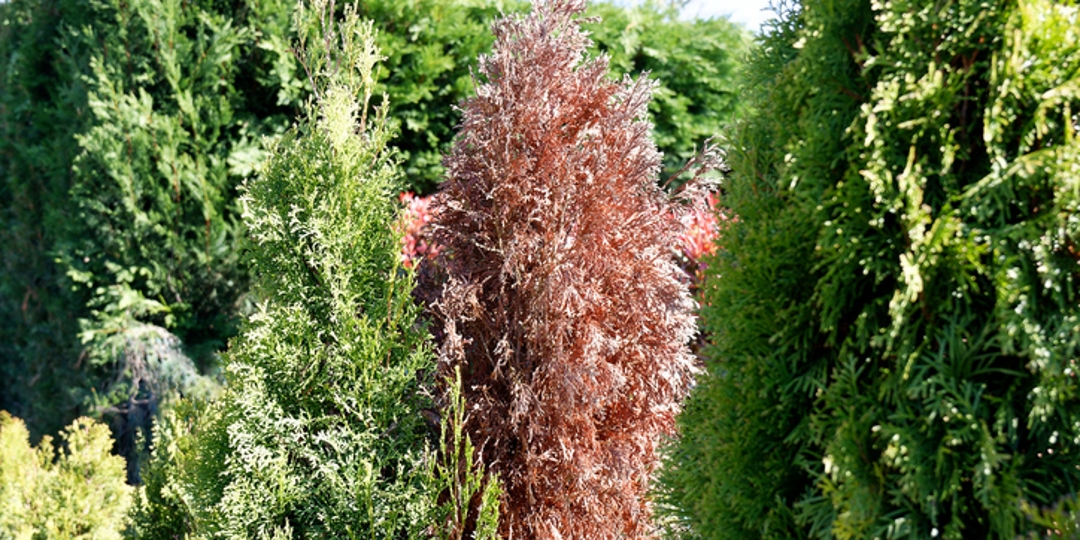Why Does My Evergreen Look Sick?
Evergreens are trees and shrubs that keep their beautiful green foliage year-round. So, you may be wondering why your evergreen needles are browning. If you’re asking, “why does my evergreen look sick,” don’t worry. You’ve come to the right place! Evergreens are still susceptible to life cycle changes, dehydration, and disease despite their hardiness. Our certified arborists at Monster Tree Service walk you through four reasons why your evergreen looks sick and share how to revive your ailing tree. With our help, you’ll be able to flex your green thumb and keep your evergreen — green!
4 Reasons Your Evergreen Looks Sick
Unlike deciduous trees, evergreens keep their green leaves year-round. So, if your evergreen looks more ever-brown, something else may be going on. Here are four reasons why your evergreen might look sick.
#1 Life Cycle Stage
Sometimes, browning needles loss are a normal part of your tree’s development. For example, newly planted evergreens are under a lot of stress while they adapt to a new environment and take root. Transplant shock can cause some needles to brown or yellow and even fall off. However, if the inner branches change color but the outer branches remain green, there is probably no reason to worry. Continue to water the tree and lay a 2-3 inch layer of mulch to protect the growing root system. If your tree doesn’t recover within a few months, consult an arborist to help restore your tree’s health.
#2 Soil Quality
Humans need a healthy diet to grow healthy and strong. Trees need nutrient-rich soil to do the same! Soil performs essential functions for your tree, including filtering pollutants, regulating hydration, and supplying nutrients. If your evergreen tree appears sick, the soil may not be the best quality. Evergreens need soil with higher acidity, good moisture retention, but not too wet as evergreens prefer not to have “wet feet,” and adequate drainage. Dry, alkaline, and nutrient-stripped soils can’t give your evergreen the resources necessary to thrive. Make sure to water regularly. A professional soil analysis will reveal the current state of your soil and offer insight into how to adjust it to aid your tree’s growth.
#3 Dehydration
If your evergreen has yellow or brown needles, it may be dehydrated or too wet. Tree dehydration typically occurs with extreme fluctuations in weather. In cold months, “winter burn” occurs when the ground becomes too frozen for the tree to access water and nutrients. During the summer, drought and heat waves can deplete water reserves, leaving the tree with an inadequate supply. If you think your evergreen may be dehydrated, call our team to have a professional arborist for a free evaluation and estimate. Also, remove any obstructions, like weeds, that could be taking nutrients from the tree or blocking water absorption.
#4 Disease
Stressed or damaged trees are more susceptible to disease and pest infestations. Common evergreen insect and disease issues include root rot, rust, needle cast/blight, as well as bagworm, mites and pine weevil infestations. Disease and pest infestations typically start in a small area and spread, sometimes affecting neighboring vegetation. So, it is important to take preventative measures and early action. One of the best ways to help prevent evergreen tree disease is through regular tree trimming and pruning.
How to Revive Your Evergreen If It Has…
Signs of a Tree Disease
If you suspect your evergreen has a tree disease, prune the affected branches and remove any fallen debris or needles from the site. Consult a certified arborist about insect and disease management if the problem continues.
Winter Weather Damage
Evergreen winter damage can include frost burn and broken branches, leading to pest and disease infestations. In most cases, your evergreen needs time to heal and will look better by spring. However, there are some things you can do to help it along. Prune any broken or dying branches causing stress to the tree.Your evergreen should green up in no time!
Dehydration
In most cases, your browning evergreen is probably just dehydrated. Prune and remove any broken branches or limbs causing stress to the tree. Cutting the weight will make it easier for the tree to supply water to the growing branches that need it. Next, remove any weeds and mulch a two to three-inch layer around the tree's base to help retain moisture. Monster offers products to aid in moisture management to avoid issues that can develop as a result of improper watering methods.

